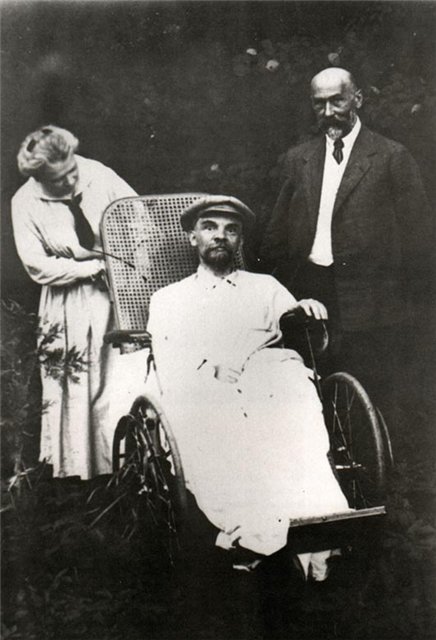Lenin suffered a degree of physical debilitation consequent to the wounds from the attempted assassinations; he retained a bullet in his neck, until a German surgeon removed it on 24 April 1922.He also reported fatigue and headaches; in March 1922 physicians prescribed rest, as it was felt that his demanding schedule contributed to a decline in health.
Upon returning to Petrograd in May 1922, Lenin suffered the first of three strokes, which left him unable to speak for weeks, and severely hampered motion in his right side. By June, he had substantially recovered; by August he resumed limited duties, delivering three long speeches in November. In December 1922, he suffered the second stroke that partly paralysed his right side, he then withdrew from active politics. In March 1923, he suffered a third stroke; it ended his career. Lenin was mute and bed-ridden until his death but officially remained the leader of the Communist Party.

Persistent stories mark syphilis as the cause of Lenin’s death.
The Soviet government publicly announced Lenin’s death the following day, with head of State Mikhail Kalinin tearfully reading an official statement to delegates of the All-Russian Congress of Soviets at 11am, the same time that a team of physicians began a postmortem of the body.[292] On 23 January, mourners from the Communist Party Central Committee, the Moscow party organisation, the trade unions and the soviets began to assemble at his house, with the body being removed from his home at about 10am the following day, being carried aloft in a red coffin by Kamenev, Zinoviev, Stalin, Bukharin, Bubhov and Krasin. Transported by train to Moscow, mourners gathered at every station along the way, and upon arriving in the city, a funerary procession carried the coffin for five miles to the House of Trade Unions, where the body lay in state.
Over the next three days, around a million mourners from across the Soviet Union came to see the body, many queuing for hours in the freezing conditions, with the events being filmed by the government.On Saturday 26 January, the eleventh All-Union Congress of Soviets met to pay respects to the deceased leader, with speeches being made by Kalinin, Zinoviev and Stalin, but notably not Trotsky, who had been convalescing in the Caucasus.Lenin’s funeral took place the following day, when his body was carried to Red Square, accompanied by martial music, where assembled crowds listened to a series of speeches before the corpse was carried into a vault, followed by the singing of the revolutionary hymn, “You fell in sacrifice.”
Three days after his death, Petrograd was renamed Leningrad in his honour, remaining so until the dissolution of the USSR in 1991, when its former name Saint Petersburg was restored, yet the administrative area remains Leningrad Oblast. In the early 1920s, the Russian cosmism movement proved so popular that Leonid Krasin and Alexander Bogdanov proposed to cryonically preserve Lenin for future resurrection, yet, despite buying the requisite equipment, that was not done. Instead, the body of V. I. Lenin was embalmed and permanently exhibited in Lenin’s Mausoleum, in Moscow, on 27 January 1924.
Despite the official diagnosis of death from stroke consequences, the Russian scientist Ivan Pavlov reported that Lenin died of neurosyphilis, according to a publication by V. Lerner and colleagues in the European Journal of Neurology in 2004. The authors also note that “It is possible that future DNA technology applied to Lenin’s preserved brain material could ultimately establish or disprove neurosyphilis as the primary cause of Lenin’s death.”
In a poll conducted in 2012 by a Russian website, 48 per cent of the people that responded voted that the body of the former leader should be buried.
In July 1929 the Politburo agreed to replace the temporary mausoleum with a permanent granite one, which was finished in 1933.The sarcophagus in which Lenin’s corpse was contained was replaced in 1940 and again in 1970.From 1941 to 1945 the body was moved from Moscow and stored in Tyumen for safety amid the Second World War.
